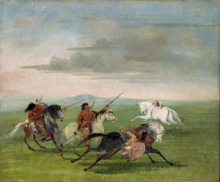Article
The Comanche are a Plains Indian tribe federally recognized as the Comanche Nation, with about half the of the nation's population residing on their designated reservation land near Lawton, Oklahoma. The Comanche language is part of the Uto-Aztecan linguistic family within the Shoshone dialect, but is spoken by very few people today. Because of their mastery of the horse, imported by Spansih colonists, the tribe had a large reign over the Southern Plains, including areas in what is now New Mexico, Colorado, Kansas, Oklahoma, and Texas. They were nomadic people who hunted bison and were known by the other tribes as aggressive, often taking captives in the practice of "raiding and trading," a form of contemporary economic exchange employed by many of the more moblie indigenous groups in North America through the early nineteenth century. The name Comanche comes from the Ute word "enemy," and narrativized and metaphorical depictions of the regional fear engendered the Comanche have found their way into vernacular ceremonial performances in cultural groups along the northern Rio Grande in New Mexico, including the Tewa Pueblos' and northern New Mexican hispanic traditions of the Comanche Dance.
Comanche Feats of Horsemanship, 1834, Oil on canvas, by George Catlin is licensed under Public Domain.
Manuscripts
References
Kavanagh, Thomas W.
2001 Comanche. In Handbook of North American Indians. R. DeMalle, ed. Pp. 907-925, Vol. 13 Part 2. Washington: Smithsonian Institution
Pritzker, Barry
2014 "Comanche." The American Mosaic: The American Indian Experience. http://americanindian2.abc-clio.com/Search/Display/1463306?terms=comanc…, accessed June 26, 2014.

